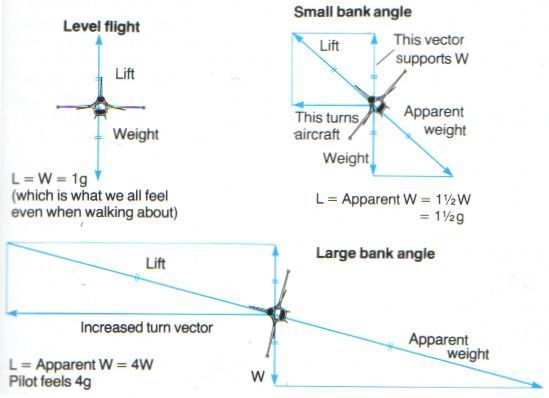I’ve just read an article by somebody who got a flight in an F16, and he reported that you would enter a turn at say 450kt and come out also at 450kt. The aircraft just managed to retain its energy.
Whereas our little planes seem to lose a lot of energy i.e. you have to add a load of power for the turn.
What controls this effect?
Depends on how much you bank. This should explain most of it

I suspect the ability of a jet fighter to maintain speed when pulling G comes down to their having a huge amount of available power. Their aspect ratio certainly does not help, and standard military practice remains to slow down for landing by pulling lots of G.
Yesterday I watched a privately owned T-38 (or F5?) taking off at my base, from a vantage point not far from the runway. The earth shaking acceleration and noise made the biz jets that more commonly operate from the same runway seem like Cessna 150s.
Peter wrote:
What controls this effect?
His afterburner probably? 
Silvaire wrote:
I suspect the ability of a jet fighter to maintain speed when pulling G comes down to their having a huge amount of available power
F16 is very overpowered, I was told it does climb from stall/slow flight on power only !
So I expect recovering speed in high G turn to be a non-event
How about autothrottle?
Speed, power and pitch. Not different from our planes, but with different numbers.
Ibra wrote:
afterburner
An English-Electric Lightning pilot told me that applying full throttle when starting a turn caused the plane to run out of fuel before completing 360 degrees – this would definitely reduce the speed 
It is claimed to have the heighest Thrust-To-Weight ratio of 1.15 ahead of the Typhoon/Rafale and behind space shuttle and NASA rockets (caveat: at empty weight, but I am sure if that can include pilot & enough fuel for 360  )
)
EuroFlyer wrote:
Speed, power and pitch. Not different from our planes, but with different numbers.
+1
It is the consequence of needing to cancel the “apparent weight” vector to maintain altitude as explained in LeSving’s sketches above (very nice btw, thank you)
You do it by increasing lift . And this is paid for by increased drag. This costs energy, so if you do not add power, the aircraft will lose airspeed.
As you can see on the Cl/Cd graph above, there is a sweet spot for maximum L/D – aircraft specific.
So maybe the F16 kept its 450 knots (bastard !  ) by losing some altitude?
) by losing some altitude?
Peter wrote:
What controls this effect?
Apart from the obvious, a big engine… Lots of clever aerodynamics that still give acceptable drag at high Mach numbers (i.e. super critical shapes that delay the shockwave), but also “relatively” low drag at high alpha, For example the leading edge strakes from the wind root forward along the fuselage and the relatively un-swept wing.
Consider much faster fighters like the previously mentioned lightning and the Lockheed starfighter its my understanding these cannot maintain their energy anywhere near as well.